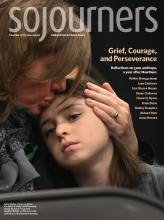IN THE FOREWORD to Where Justice and Mercy Meet: Catholic Opposition to the Death Penalty, Sister Helen Prejean writes, “Welcome to the pages of this amazing book.” Her hospitable remark is not an exaggeration. I have written articles, taught classes, and spoken to church groups about capital punishment; in my judgment this book is the most accessible resource now available for engaging, informing, and perhaps even transforming how readers view the death penalty.
Where Justice and Mercy Meet was edited by death penalty activist Vicki Schieber, philosopher Trudy D. Conway, and theologian David Matzko McCarthy. The book is the product of two years of interdisciplinary courses, discussions, projects, and research—in sociology, political science, philosophy, economics, theater, ethics, and theology—at Mount Saint Mary’s University in Emmitsburg, Md. While the book has a Catholic focus, it should be useful to Christians of all stripes and others interested in addressing this issue.
The volume is divided into four parts. Through skillful section and chapter introductions and segues, the editors have done a fine job of creating an integrated whole. Relevant questions for discussion and action tips make the book perfect for study groups in churches and for the university classroom.
Part I, “The Death Penalty Today,” exposes the realities of the dominant current method of execution (lethal injection), surveys the history of the death penalty debate in the U.S., and suggests the significance of reading or hearing the stories of those affected by murder and capital punishment. Kurt Blaugher’s chapter, “Stirring Hearts and Minds,” meditates on the role of drama in allowing these stories to capture and broaden our imagination, to stimulate reflection, and to compel us to take action for social change. Indeed, stories—from real life as well as from film and literature—surface throughout the volume, with the most moving and memorable ones being the experiences and voices of those whose loved ones were murdered.
Read the Full Article
